Making of Female Finn Viking Dress
© Satu Hovi 2005 / 2011 / 2017
Female Finn Viking Dress consists of 6 parts: underdress, overdress, apron, leg girdles, cloak and headdress. Apron was tied with a seperate tablet woven belt, likewise leg girdles. Magnificent bronze jewellery belonged to the costume.
In this picture I am wearing the Eura dress, a replica from Luistari cemetery in Eura, grave 56. Jaana Riikonen, an archaeologist, who has done a remarkable amount of research of these costumes, has the opinion that the Finnish dresses were actually much shorter than this one, about halfway to the leg. Leg girdles were used to cover the legs. That made it easier to walk in the snow, for example. The veil that I am wearing is not very typical for this period and place. Women in Viking Age wore a certan headdress called "Arch veil", in Finnish kaarihuntu.
The materials used were wool (overdress, underdress, girdles, apron, headdress, mittens, belts and garters) or nettle or hemp (underdress, a possible under tunic, weft for the bands). Linen that is found from the graves was a luxury import from Europe and rather rare, as is silk. The few finds of luxury cloth we have were mostly found from male graves.
Pieces of costume were grown, spun, dyed, woven and stiched at home. Colorful, tablet-woven patterned bands for final decoration, used for belts and tying up hair, were bought from the local market. Due to the fact that Finns still did weave their fabrics using warp weighted looms, the costumes in Finland had same very interesting details as all Northern clothing in earlier period. These small details that were made during weaving and finishing the piece of cloth, cannot be seen from very far, but are a very important part of the costume.
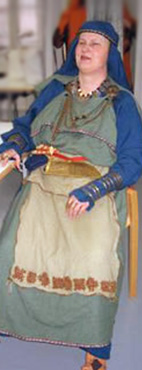
This picture is from an exhibition in the National Museum, Helsinki. These warp weighted looms had already became old fashioned in Scandinavia at the very same period. Our Scandinavian neighbours began to use the next model, the horizontal looms, in the beginning of the Viking Age. Their costume changed with this.
Some researchers in Finland nominate Viking Age the Younger Iron Age. In the Middle Ages these costumes were still in use in the Middle of Finland and in Carelia. There are no more grave finds from west coast Finland after 1200. I believe that this costume continued to be commonly worn among people living in the countryside through the Middle Ages until the renaissance. The costume was altered a little, though. The decoration changed: spirals became oldfashioned little by little. The jewellery changed: new material and styles came into fashion. It was not so important to walk wearing all your savings anymore.
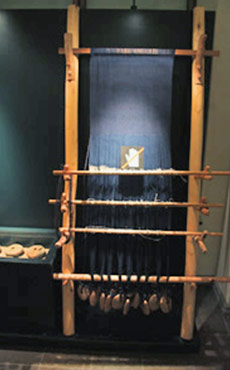
Pieces of a female Viking Finn costume
Underdress
The exact cut of the underdress is uncertain. There are only small pieces left in the graves. For example in the grave 56 in Luistari cemetery, Eura, only two pieces of underdress textile has survived. We can only assume that the sleeves were very long and narrow, the dress had a straight neckhole, which was not cut into curves and the neckhole was open to rather down to allow easy nursing.
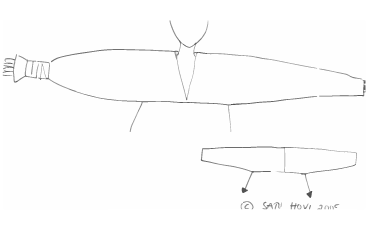
This photo is from an exhibition in the National Museum, Helsinki. It is an upper part of the grave 56 in Luistari, Eura. One textile piece under the shoulder brooch contained fabric selvage. That lead the professors to a conclusion that the neck opening was a straight one, not vertical, but diagonal. If the opening is as long as to the nipples, it is very easy to nurse a baby: open the other shoulder brooch, reveal your shoulder and go. That was a very practical costume to wear.
The other survived piece in Luistari, grave 56 was found inside the armring. This big piece of cloth had no hemmed cuff, so the researchers think that the sleeve was cut to be too long in purpose, about 20 cm longer than normal sleeve length. The sleeve was rather narrow. Narrow but a long one.
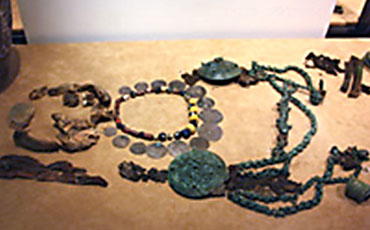
The horizontal seam goes over the top of nipples. The arm ring keeps the long sleeve in its place and holds the length beautifully. The sleeve is so long that it ends to halfway palm, when arm rings are in place. The cut of the piece was likely designed in such a way that the brick wall - tablet woven band that is woven to the fabric meets both the hem of the dress and the wristband of the sleeve.
Overdress
Overdress was either a square piece of woollen fabric, mostly 2/2 twill, or two rectangular ones. The upper part of an overdress was sometimes turned double, sometimes worn plain and sometimes extra small pieces were added to give a folded look. This piece was sometimes decorated using simple stiches. The two rectangulars were sometimes sewn together from one or both sides, sometimes not. The rectangular was sometimes stiched to a tube.
The overdress got selvages and tablet-woven bands woven into the starts and ends of the loom. Some square fabrics were worn sideways. That means that the warp line goes horizontally, not vertically when worn. Colored, patterned tablet woven bands were stiched into the side of wrist and hem.
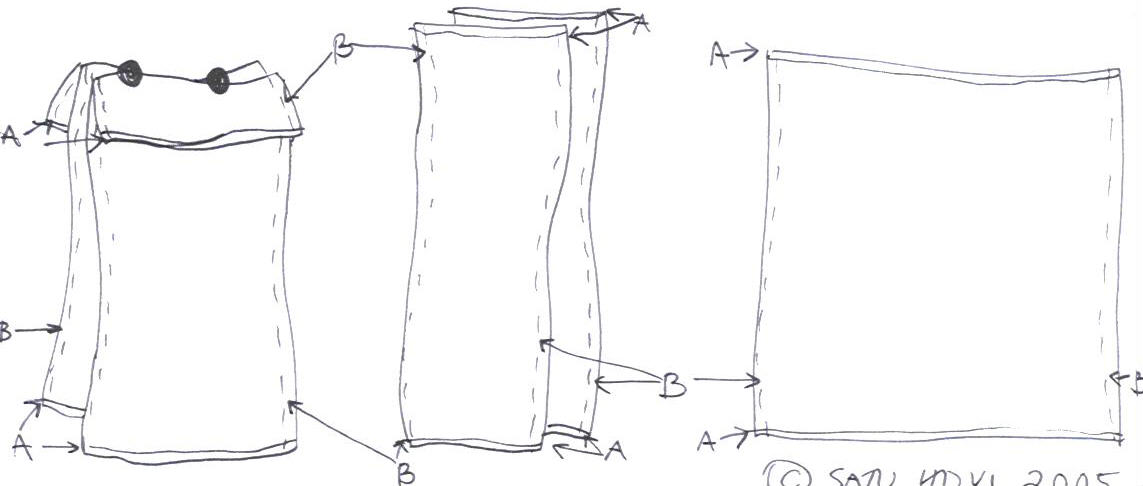
A= two tablet woven bands, first the brick wall - one that is woven to the fabric. A colorful, decorated one is stiched to the side of the first band, or to the selvage if the cloth is worn sideways (A and B switches their places in that case).
B=Double selvage, which is made when weaving the fabric.
The finishing of the woven garment with table woven bands using the woven warp as the weft of the band. First, I took a group of warps (3-6 in tunics) which I used as a weft and placed them to the left through the open warp. Then I turn the tablets and placed the group of warps back to the right through the open warp.
The overdress was worn on by two round brooches. Chains were hanging from chainholders in between. Sometimes, if the lady was not a wealthy one, the dress was tied with one or two wooden or bone sticks. Sometimes the overdress was stiched from either one or both shoulders.
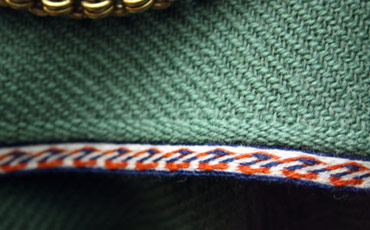
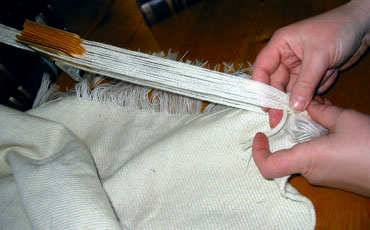
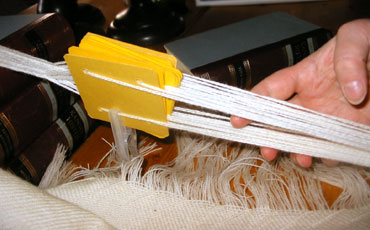
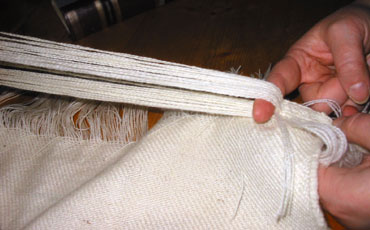
Apron
Unlike Scandinavian Viking ladies, Finnish females during Viking Age always wore an apron. The apron was a rectangular piece of fabric, which was tied around the body with a long tablet woven band. The material was wool, mostly 2/2 twill, with a sentence going down, unlike twill today.
A rich woman from the 10-11th centuries had spiral brone decorations attached to the bottom of her apron. Every apron had a unique decoration, no two similar aprons have been found. For example the richest grave in Luistari cemetery, grave 56, dated between 1025-1050 AD, had probably nine spiral ornaments in line in the bottom of the apron (only five of them has survived).
As a conclusion researcher Lehtosalo-Hilander has written that at first a woman had rich spiral decorations in her apron. Later on, when she became wealthier, she got also the round brooches on her shoulders. Poor women had no spirals, nor bronze jewellery.
Belt
Belt was woven with tablets. It could be one-colored or colorful. The weft was of fiber plant, nettle or hemp undyed (Sarkki). The belt has to go around your body twice and then tied, so make it a long one. Knive was hanging from the belt.The ends of the belt should always be beautifully finished. Some examples: - Make a group of finger looped bands - Make three plaits, about five centimeter long, and stich them together side by side. This technique was found from a grave in Perniö, dated to about 1200 (Appelgren-Kivalo).
This is how to tie a Finnish apron. First, place the apron against your body beyond the waist. Wrap the belt around you once. Then turn the part that is beyond the waist down. Wrap the belt around your waist the second time. Now you should put in place all the equipment that hang from the belt, for example the knife. Tie the belt very tightly.
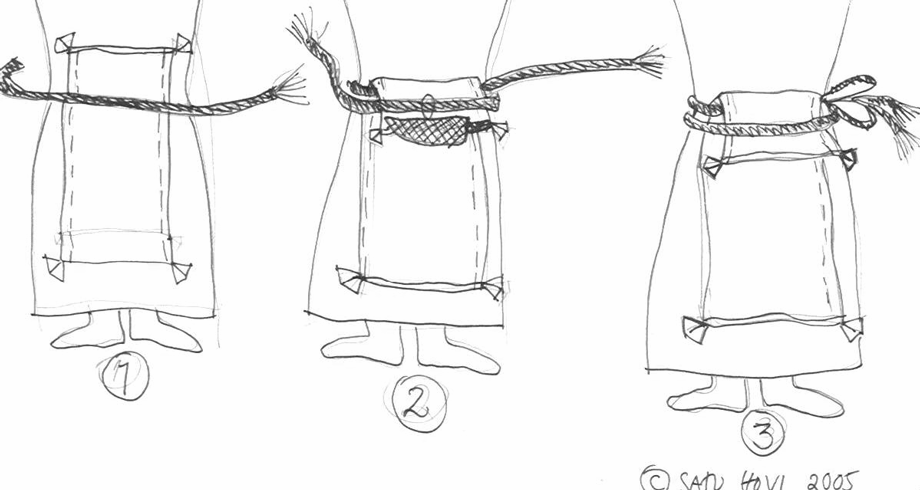
Headdress
A typical headdress in the Viking Age Finland was so-called Arch veil (kaarihuntu). There are lot of finds of such headpieces. Sari Raitio made one and is wearing it in this picture (This picture was first published in Euran puku ja muut muinaisvaatteet by Lehtosalo-Hilander, p. 70. Photo by Pekka Kujanpää).
These are the leftovers from an Arch Veil, found from Humikkala, Masku. It is now in an exibition in the National Museum of Helsinki.
In a grave dated to about 1200 A.D. in Perniö traces of a veil have been found. A wollen square veil, which was folded double into a triangel. Into the side of the fold, placed in center, a tablet woven band is stiched for a lenght of about 20 cm. Inside the fold a piece of birch bark was placed. It gives a crownlike look and makes its wearer to look very grand. This technique is introduces in the making instructions of Perniö dress replica - Perniön puku.

Cloak
There are traces from cloaks. They were rectangular, woollen 2/2 twill, with double selvages and tablet-woven bands in the starts and ends of looms. The cloak in this picture is a replica from a 10th century male cloak. Female cloaks looked very likely alike.
These are different spiral decorations, which have been found attached to either cloaks or tunics. The one in the middle left is actually a part of belt decoration. They are found from several graves in Luistari, Eura. Now they stay in the exibition in the National Museum of Helsinki.
There were often spiral ornaments attached, or "fans", spiral corner decorations. These were threaded into bands made by fingerlooping technique. This was a practical way to hide ends of the tablet woven band looms. Rich grave finds dated about 1100-1200 have large finger-looped band gratings with small and fine spiral ornaments.
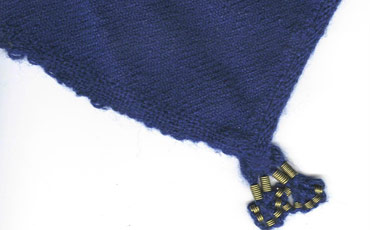
Mittens
In most of the graves, maybe in every one of them, nålebinded mittens were included. The mittens in this picture are a replica of the mitten leftovers in Luistari, grave 56. The researchers are discussing the meaning of those mittens. Whether they are symbolic: to be given to the ferryman as a payment when dead and in that case added to the dress as late as during the funeral ceremony; or they were really worn in the cold climate.
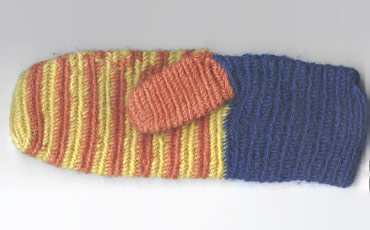
Girdles
Nålebinded socks and leather shoes were worn. Girdles were worn when it got really cold. They were about 10-12 centimeter wide, three meter long each. They were tied around the leg with garters woven with tablets.
A girdle that was found from Kaarina, Kirkkomäki, 12th century, was made of woollen lozenze twill with double selvages. It was tied with narrow tablet woven gartes with spiral ornaments in the both ends.
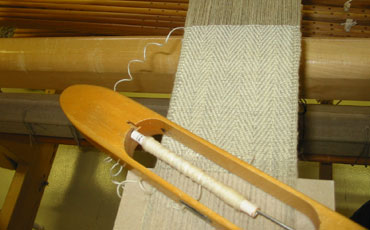
Weaving details
The selvages in ancient fabrics were always some way strenghened. In Viking Age Finland the weavers used a technique of double selvage. The double selvage was always plain weave, though the fabric created between the left and right selvage was mostly twill. Fabrics got about 16- yarn - wide plain weave selvage, which turns into double during weaving.
A Viking weaver used warp weighted looms, but these double selvages can be made using modern looms with four heddle rods as well. Teacher Hannele Köngäs invented a technique, where heddles in the left got 16 yarns to the rods 1 and 3 in turn, and heddle rods 2 and 4 are to left empty. heddles in the right side got 16 yarns to the rods 2 and 4 in turn, and heddle rods 1 and 3 are to left empty. Weaving starts from the left, but the 16-yarn selvadge is left always unwoven in the beginning of each level. The shuttle finishes each level normally.
If you cannot weave the fabrics yourself, you could buy the fabric from a store and do either or both the following:
- fold the selvages into double. Stitch them 0,5 cm wide.
- weave a narrow tube band with tablets and attach it to the selvage
You also could:
- fold the selvages into double. Stitch them 0,8 cm wide. Insert a band inside to get a round effect to the selvage.
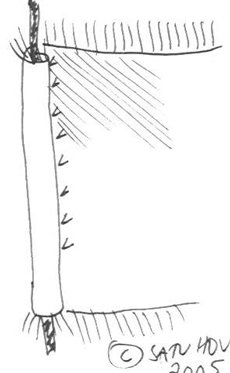
Finishing your piece of costume before adding decoration
The end - yarns of fabrics were finished with tablet woven bands, where these end - yarns of fabric were used as a weft, in groups of four. According to Seija Sarkki a typical feature to Finnish tablet woven bands that are woven into the fabric is so called brick wall- outlook. That is made by placing yarn through only two of the four holes of tablet, the opposite ones, look at this picture.
Two tablets in pairs (same position, but yarn goes into from the opposite direction) are common. Both sides of the loom are placed normally from one to four yarns through each four holes. The tablet in outermost side has four yarns in each four holes, which makes the outside of the tablet very beautiful.
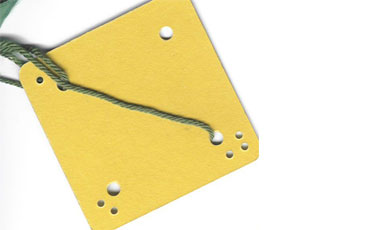
This picture of overdress band patterns that are woven into the fabric is copied from unpublished working instruction manual for Eura dress replica (Luistari, grave 56) made by Erja Valtonen. These are my favourite instructions, I like the look of these two bands very much. There are, and were, many other patterns for these brick wall - bands as well.
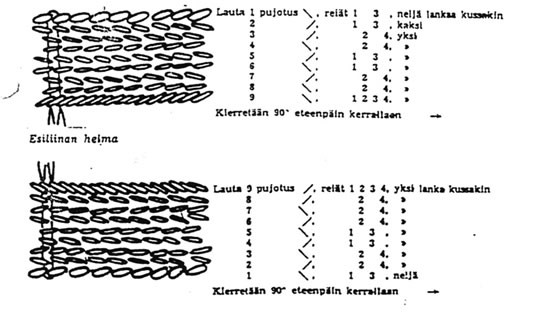
In this picture you can see the weaving of such band in process. End yarns of the loom are used as a weft, here in groups of four (depends on yarn thickness). The group goes through the loom once, the tablets are turned and the same group comes back again. The tablets are turned and a new group of yarns is used as a weft and to be continued... Notice the beautiful brick wall - structure.
If you want to use this method to a fabric bought from a store, buy 8 cm extra length and take about 4 cm warp apart from both ends. Weave bands to both ends of fabric.
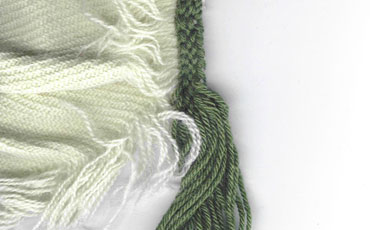
Finishing of the tablet-woven bands
Tablet woven bands that are woven into the fabric were used to fabrics that were cut into pieces, too: tunics, underdresses etc.
In this picture here is a hem of a tunic. Finishing like this is very tough and stays well-looking even after long wear. The brick wall - structure is here again, of course. This is a wrong side of the tunic, and you can easily see small warp leftovers of red tablet woven band. These are cut after finishing the band. Ends of the looms of the tablet woven band were not used into decoration, because spirals were this time considered to be unpractical. Note - weave the bands before cutting the fabric. Choose a pattern for your costume that places both the sleeve hem and the hem of your dress / tunic / other onto the brick wall - finishing band.
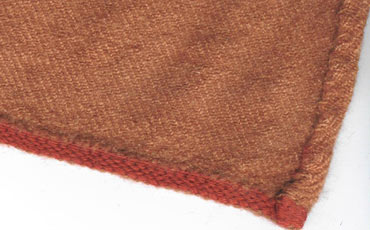
Ends of the looms of tablet woven bands were woven into (here four) finger-looped bands. These bands are each woven with 3 loops, since using more loops to create one band would make it too thick to be used in decoration. Pieces of spiral decoration are threaded to those to form a "fan" decoration.
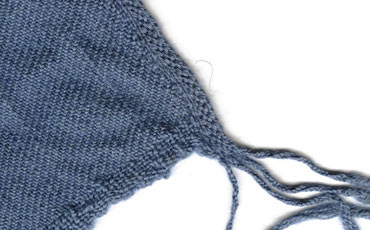
This picture demonstrates the method of making a simple finger-looped band. Make 3 loops from a tightly spun yarn and tie them all together from the bottom. Find a weight, tie it and let it hung towards the floor. It does not need to be a very heavy item, my bigger scissors are in most cases heavy enough. Take one of the loops to the finger of your right hand and two to the fingers of the left. Turn palms of your hands towards your face. Put the loop you have in your right hand through each of the left in turn and switch them from a hand to another. Spread your hands out between switching. When you are using this method to yarn that is attached to fabric, you just tie the upper ends - note that you may have to add some extra yarns to get the right amount of loops.
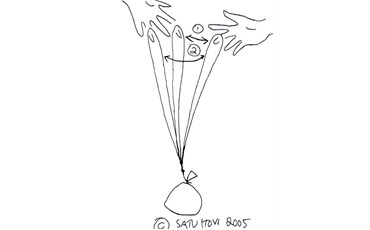
Patterned and colorful tablet woven bands
Patterned and colorful tablet woven bands, were stiched either to the side of the finishing brick wall -patterned tablet woven bands or the selvage, depending on how the overdress fabric was placed to wear. Bands were made of thin wool and were very narrow, about 1 cm wide. Weft was made of nettle or hemp.
Sometimes a bit thicker yarn were used for belts. Many of them are about 2 - 3 cm wide.
Patterns were often very complicated ones, and very sophisticated weaving techniques were used. The maker of these bands was most likely a professional band weaver.
Spiral decoration
Spirals were mostly used to decorate aprons and cloaks. The amount of spiral decoration used in one outfit increased from the start of their appearance (9th century) towards the most fashionable season, 11th century.
Some spiral decoration has been used to finish tablet woven leg bands and 9th century male tablet woven belts.
In this picture there is a replica of a male belt of 10th century from the grave 100 in Luistari graveyard. The book Luistari I - the graves by Lehtosalo-Hilander has many photos of these belts. The diameter of the spiral wire should be somewhat bigger than used in this picture. So far no spirals that could decorate female belts are found from graves.
The size of the spirals varied. In the beginning of the season the diameter of bronze wire was as much as 1,5 mm, or more in male spiral belts, and the diameter of the tube made from the wire could be 5 mm.
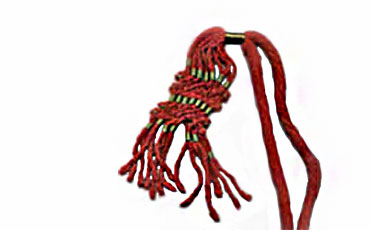
This male cloak replica is from Luistari, grave 358, 10th century. The diameter of the wire is about 0,5 mm.
Thinner wire got more fashionable within time. During the 12th century the fashion in female costuming changed. Spiral diameter was smaller than in earlier centuries, because of the new fashion and a new outlook: lightweight silver jewellery. The ornaments attached to cloak in Masku dress replica (from about 1100) were only about 1,5 cm by diameter.
Spirals were made into tubes, which were cut into different lengths. The wire used at that time was a mixture of bronze and brass, mostly brass. Typical for the spiral fashion of the Viking Age is that the tubes were opened every 5 mm length. When they are placed in angles, the openings will meet and form crosses, where the red yarn can be seen. The small spiral loops in the ends are for turning when the ornament is made, and also for stitching the ornament into the fabric when finished.

The right down corner of an 11th century apron replica. Down is the brick wall - decorated tablet woven band that is woven into the fabric. In the side there is a variation of double selvage, a hollow plain weave selvage. It was a version designed by 20th century researchers. The corner "fan" decoration of that century has two layers in the top; which is not the simplest form of "fan" that appears in the graves. The apron is outlined with pieces of spiral tube. Spiral ornaments are attached to the apron, which is very typical to 10th and 11th centuries. Women collected ornaments using spiral tubes, which they attached to aprons. These ornaments in the picture attached are about 5 cm by diameter, and the diameter of the spiral tubes is about 3 mm. They should have been made from a 1 mm bronze wire, but this is thinner. During 9th century the decoration of an apron was rather simple; the only spirals were these "fans" in apron corners. During 10th century an outlining with pieces of spiral tube was added. During the 11th century spiral ornaments were attached to the apron as well.
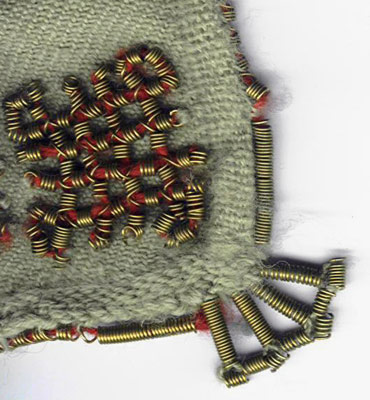
The degree of complexity of the "fan" decoration increased during the centuries. This picture is published in Euran esihistoria, written by Lehtosalo-Hilander, p. 241, drawing by Rauno Hilander. (an English summary of this book is available in Eura museum, Naurava Lohikäärme). In the beginning of the 9th century, when this model first appeared to the apron, the "fan" was simple, but became larger and more complex until the end of the 11th century.
All apron corners had at least "fans" as a decoration (at least if the woman was a wealthy one). Finns did not bother to waste material putting expensive spirals into places where they were not seen. So, overdress was made with double selvage and attached tablet woven bands, just like an apron, but lacking spiral "fans". The "fan" was a speciality of an apron and a cloak.
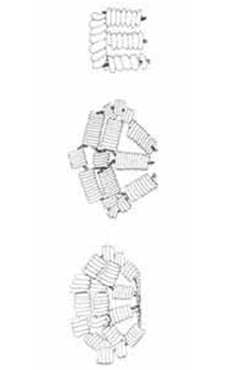
The wrong side of an apron. You can see the long stitches attaching the spiral ornaments. You can hardly see the warp leftovers of a green tablet woven band. They are cut after finishing the band, but they could also left uncut as fringes. According to Tyyni Vahter (a former researcher of the difference of spiral decoration in different parts of Finland) the women in Finland liked to build their spiral ornaments with red yarn dyed with madder. The yarn used to collect an ornament from spirals was very thin, since it was not used as such, but made into finger-looped bands.
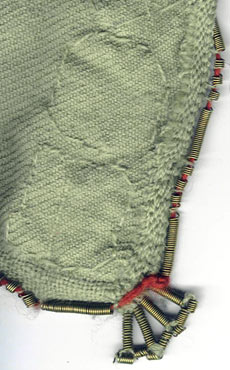
Bibliography
Published sources
Appelgren-Kivalo, Hjalmar: Suomalaisia pukuja myöhemmältä rautakaudelta. Helsinki, 1907 (1908).
Geijer & Arbman: En detalj i den Gotländska mansdräkten under vikingatiden. Fornvännen 1940.
Hannusas, Susan & raitio, Sari: Morsinkovärjäys - historiaa ja kokeiluja. Turun maakuntamuseon monisteita 12. 1997
Hassi, Terttu: Kasvivärjärin ohjekirja.
Hägg, Inga: Berichte ûber die ausgrabungen in Haithabu. Bericht 20. Die textilfunden aus dem Hafen von Haithabu. 1984.
Ken kantaa kalevalaa. Kalevala Koru 100-year celebration exhibition booklet. 1985.
Lehtosalo-Hilander, Pirkko-Liisa: Ancient Finnish Costumes. Helsinki, 1982
Luistari 1-II. SMYA 89. Helsinki, 1989.
Luistari IV. SMYA 107. Helsinki, 2000.
Euran esihistoria. Vammala 2000
Euran puku ja muut muinaisvaatteet. Vammala 2001.
Raitio, Sari: Kankaiden aloituksia ja lopetuksia sekä putkihulpion kutominen loimipainoisissa pystykangaspuissa. Turun maakuntamuseon monisteita 2. Turku 1991.
Sarkki, Seija: Suomen ristiretkiaikaiset nauhat. HYAL moniste no 18.
Suomen historia I. Weilin & Göös, 1982.
Tallgren, A. M.: Esihistoriallinen puku Viron Pärnumaalta. Suomen Museo 1923.
Thunmark-Nylén, Lena: Dräkt och dräktsmycken på Gotland under vikingatiden. Gutar och Vikingar.
Tomanterä, Leena: Kaksi Köyliön miekkahautaa. HYAL moniste no 16. Helsinki, 1978.
Vahter, Tyyni: Pronssikierukkakoristelun teknillisistä menetelmistä. Suomen Museo 1949.
Working instructions for the ancient dresses from Perniö and Mikkeli.
Zarina, Anna: Neue Funde der Lettgallischen Männertract aus dem 11. Jahrhundert. Textilsymposium Neumünster (NESAT V), Neumünster, 1994
Unpublished sources
Helkiö, Erja Kaarina before called Valtonen), a written consultation and weaving instructions of a men's cloak, February 2001.
Torvinen, Elisa: Vilusenharjun vaippa. Rekonstruktio Tampereen Vilusenharjun kalmiston haudan numero 2 myöhäisrautakautisesta naisten vaipasta. Syventävien opintojen tutkielma, Helsingin Yliopisto, kasvatustieteellinen tiedekunta, 1997.
Valtonen, Erja (now called Helkiö): The weaving instructions for the ancient dress from Eura.
Valtonen, Erja (now called Helkiö): Viikinkimiehen viitta. Artesaanityö. A graduation work from the Satakunta School of Handcrafts.
Working instructions for an ancient dress from Carelia
Non-written sources
Lehtosalo-Hilander, Pirkko-Liisa: a lesson held in the National Museum of Finland in March 12th, 2002.
Riikonen, Jaana: a lesson held in the symposium of ancient Finnish dresses held in Helsinki on February 2nd, 2002.